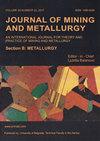Co-Al-W高温合金的感应真空熔炼——基于合金的化学成分、元素偏析和炉渣形成优化原料
IF 1
4区 材料科学
Q3 METALLURGY & METALLURGICAL ENGINEERING
Journal of Mining and Metallurgy Section B-Metallurgy
Pub Date : 2022-01-01
DOI:10.2298/jmmb211107002m
引用次数: 0
摘要
本文讨论了在真空感应炉中熔炼Co-Al-W合金,并考虑了原料形貌的优化。本文分析和描述了各种进料条件和合金元素引入液态合金的顺序对合金的影响。研究表明,利用真空给料机将破碎的钨粒引入液态Co-Al- w合金中,加热至最高40-50℃以上,可以获得所需的Co-Al- w合金化学成分。这种技术变体要求对熔融合金进行精确的温度控制,这并不能保证完全的再现性。该工艺的缺点是形成的渣量相对较高。最佳工艺方案是在熔炼过程结束时获得液态Co-W溶液并引入Al;在这种变型中,结渣效果相对较低。此外,与在真空中熔化相比,在氩气气氛中熔化合金可以减少由于蒸发而导致的铝的损失。冶炼过程既可以在Al2O3固体坩埚中进行,也可以在由mgo基耐火材料制成的压实坩埚中进行。本文章由计算机程序翻译,如有差异,请以英文原文为准。
Induction vacuum smelting of Co-Al-W superalloys - optimizing the feedstock based on the alloy's chemical composition, elemental segregation, and slag formation
In this study, the manufacturing of Co-Al-W alloys by smelting in an vacuum induction furnace is discussed taking into account the optimizing of the feedstock material morphology. Herein, the influence of various feedstock conditions and the order of introducing the alloying elements into a liquid alloy are analyzed and described. The investigation revealed that it is possible to obtain the desired chemical composition of Co-Al-W alloys using fragmented tungsten pellets introduced from a vacuum feeder into the liquid Co-Al alloy heated above the liquidus temperature by maximum of 40-50?C. This technical variant requires accurate temperature control of the molten alloy, which does not ensure complete reproducibility. The disadvantage of this process lies in the relatively high slag formation. The optimal technical solution involves obtaining the liquid Co-W solution and introducing Al at the end of the smelting process; in this variant, the slagging effect is relatively low. Additionally, melting of the alloy in an argon atmosphere reduces the loss of aluminum due to evaporation, as compared to melting in a vacuum. The smelting process can be carried out either in Al2O3 solid crucibles or in compacted crucibles made of MgO-based refractory mass.
求助全文
通过发布文献求助,成功后即可免费获取论文全文。
去求助
来源期刊
CiteScore
2.00
自引率
40.00%
发文量
19
审稿时长
2 months
期刊介绍:
University of Belgrade, Technical Faculty in Bor, has been publishing the journal called Journal of Mining and Metallurgy since 1965 and in 1997 it was divided in two independent journals dealing with mining and metallurgy separately. Since 2009 Journal of Mining and Metallurgy, Section B: Metallurgy has been accepted in Science Citation Index Expanded.
Journal of Mining and Metallurgy, Section B: Metallurgy presents an international medium for the publication of contributions on original research which reflect the new progresses in theory and practice of metallurgy. The Journal covers the latest research in all aspects of metallurgy including hydrometallurgy, pyrometallurgy, electrometallurgy, transport phenomena, process control, solidification, mechanical working, solid state reactions, materials processing, surface treatment and relationships among processing, structure, and properties of materials.

 求助内容:
求助内容: 应助结果提醒方式:
应助结果提醒方式:


